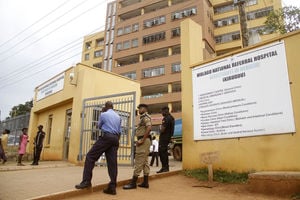
The Minister of Health, Dr Jane Ruth Aceng (left), engages Dr Yonas Tegegn Woldermariam, a former World Health Organisation representative to Uganda (right), during the 30th Annual Health Sub-Programme Joint Review Mission in Kampala on October 23, 2024. PHOTO/ ISAAC KASAMANI
The Health Ministry has named the best-performing and worst-performing districts in health service delivery during the 2023/2024 financial year.
In the health sub-programme performance report released yesterday in Kampala during the Annual Health Sub-Programme Joint Review Mission, Lira City emerged as the best performer, scoring 90.7 points, and it was followed by Kiruhura, which scored 89 percent, while Soroti City ranked third after scoring 88 percent.
Dr Sarah Byakika Kyeyamwa, the commissioner for Planning, Financing and Policy at the ministry, while presenting the report, said Rubanda emerged fourth with 84 percent, followed by Fort Portal (84 percent) and Kween in sixth with 83.6 percent.
Kween was followed by Budaka, Jinja City, Nebbi and Mbarara City as the tenth –the four districts scoring between 82.7 percent and 81.8 percent.
Dr Sam Kamba, the senior planner at the ministry’s department of planning, explained that while ranking the districts, they based on several indicators such as coverage of interventions to prevent maternal deaths, community health services and staffing levels.
“We also took into account the review of maternal deaths. We insist that every maternal death that occurs, is audited by the local government and also every perinatal death is audited,” he said.
“The percentage of the deaths that are audited and the audit report are also used in the ranking. Then we also have an assessment of the availability of medicines by the local government as well as the local government performance assessment carried out by the Office of the Prime Minister,” he added.
For the worst-performing districts, Dr Byakika also revealed that Madi Okollo was leading, scoring 51.4 percent and was ranked as the 146th.
It was followed by Lwengo with 56.3 percent and ranking as 145th, Rakai (58.7 percent), Bukomansimbi (59.3 percent) and Butaleja (60 percent).
Butaleja was followed by Sembabule, Soroti, Wakiso, Nwoya and Moroto, which scored between 60.3 percent and 60.8 percent.
Dr Jane Ruth Aceng, the Health minister, said some districts and regions with poor performance are largely because of poor leadership.
Rankings for sub-regions
According to the report, Bunyoro, ranked 15th, was the worst-performing sub-region. It was followed by north central (14th), and the two followed by Busoga and south central as the worst-performing sub-regions.
Kigezi emerged as the best-performing sub-region ranked 1st and it was followed by Bugisu, Kampala, Tooro and Teso. These sub-regions were followed by Bukedi, which ranked the sixth, and then Acholi, West Nile, Karamoja, and Ankole, which ranked tenth.
Lango Sub-region was ranked 11th despite Lira City being ranked as the best performer.
“Some of the regions that performed poorly have the best services. If you go to Bunyoro Sub-region, it is well-covered. We need leadership in that region because without it, things don’t move as well as in other regions that didn’t perform well,” Dr Aceng said.
Dr Aceng appealed to all regions to promote disease prevention to reduce the burden on the health system.
She said the government is only allocating $3.1 (Shs10,000) per person for the medicines, the amount she said is too low.
Dr Aceng said although there has been remarkable progress in several health indicators, some areas still need improvement.
According to the ministry, the country has seen a significant decline in number of mothers dying during birth from 336 deaths per 100,000 live births to 189 deaths per 100,000 live births between 2016 and 2022.
DEATHS RECORDED
In the new report, there were 48,315 deaths in health facilities in FY2023/2024, which is lower than the 53,222 deaths reported in FY2022/2023. “Maternal deaths among 100,000 health facility deliveries reduced by eight percent from 90.3/100,000 in 2022/2023 financial year to 82.7/100,000 in the 2023/2024 financial year,” the report reads.







